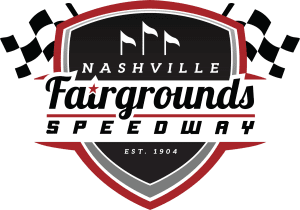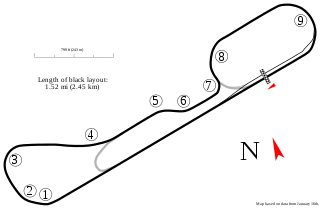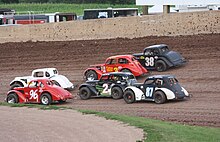
Stock car racing is a form of automobile racing run on oval tracks and road courses measuring approximately 0.25 to 2.66 miles. It originally used production-model cars, hence the name "stock car", but is now run using cars specifically built for racing. It originated in the southern United States; its largest governing body is NASCAR. Its NASCAR Cup Series is the premier top-level series of professional stock car racing. Australia, Canada, New Zealand, Mexico, Brazil, Argentina, and the United Kingdom also have forms of stock car racing. Top-level races typically range between 200 and 600 miles in length.

Daniel Sexton Gurney was an American racing driver, race car constructor, and team owner who reached racing's highest levels starting in 1958. Gurney won races in the Formula One, Indy Car, NASCAR, Can-Am, and Trans-Am Series. Gurney is the first of three drivers to have won races in sports cars (1958), Formula One (1962), NASCAR (1963), and Indy cars (1967), the other two being Mario Andretti and Juan Pablo Montoya.
AUSCAR was an auto racing sanctioning body owned by Bob Jane, which ran American-style Superspeedway racing in Australia. The initial AUSCAR venue was the 1.801 km, high-banked (24°) Calder Park Thunderdome Superspeedway in Melbourne, but over time the series expanded to include the Jane owned 1/2 mile Speedway Super Bowl at the eastern end of Adelaide International Raceway which first saw AUSCAR racing in 1990, the Surfers Paradise Street Circuit, and eventually several Australian road racing circuits including Calder Park's road course and the Oran Park Raceway in Sydney where racing was held under lights on the short version of the circuit. In the early 1990s, Jane and television station Channel 7 announced plans to turn the old Granville Showground trotting track which circled the Parramatta Speedway in Sydney into a paved, banked 1/2 mile track, but this did not happen.
The International Motor Sports Association (IMSA) is a North American sports car racing sanctioning body based in Daytona Beach, Florida, under the jurisdiction of the ACCUS arm of the FIA. It was started by John Bishop, a former executive director of SCCA, and his wife Peggy in 1969 with help from Bill France Sr. of NASCAR. Beginning in 2014, IMSA is the sanctioning body of the WeatherTech SportsCar Championship, the premier series resulting from the merger of Grand-Am Road Racing and the American Le Mans Series. IMSA is owned by NASCAR, as a division of the company.
Dirt track racing is a form of motorsport held on clay or dirt surfaced banked oval race tracks. Dirt track racing started in the United States before World War I and became widespread during the 1920s and 1930s using both automobiles and motorcycles, often running on horse racing tracks. There are a myriad of types of race cars used, from open wheel Sprint cars and Modifieds to stock cars. While open wheel race cars are purpose-built racing vehicles, stock cars can be either purpose-built race cars or street vehicles that have been modified to varying degrees. There are hundreds of local and regional racetracks throughout the United States. The sport is also popular in Australia, New Zealand, Canada, South Africa and the United Kingdom.

Katherine Anne Legge is a British professional auto racing driver who competes part-time in the IMSA SportsCar Championship and part-time in the IndyCar Series, driving the No. 51 Honda for Dale Coyne Racing with backing from e.l.f. She holds the record for the fastest qualifying effort for a woman in Indianapolis 500 history, set in 2023, and was the first woman to win a major open-wheel race in North America in 2005.

Nashville Fairgrounds Speedway is a 5/8 mile motorsport racetrack located at the Nashville Fairgrounds near downtown Nashville, Tennessee. The track is the second-oldest continually operating track in the United States. The track held NASCAR Grand National/Winston Cup races from 1958 to 1984.

Seekonk Speedway is a family entertainment venue that features racing of all kinds on a semi-banked 1/3 mile asphalt-paved oval, located on U.S. Route 6 in Seekonk, Massachusetts.
Robert Frederick Jane was an Australian race car driver and prominent entrepreneur and business tycoon. A four-time winner of the Armstrong 500, the race that became the prestigious Bathurst 1000 and a four-time Australian Touring Car Champion, Jane was well known for his chain of tyre retailers, Bob Jane T-Marts. Jane was inducted into the V8 Supercars Hall of Fame in 2000.

The NASCAR Canada Series is a national NASCAR racing series in Canada, and is a continuation of the old CASCAR Super Series which was founded in 1981. It is the top NASCAR touring series in Canada.

Pickup Truck Racing is an auto racing series, running in the United Kingdom, including races on road courses and (historically) ovals. It was the only racing series that raced on the Oval Circuit at Rockingham Motor Speedway until it closed in 2018.

Calder Park Raceway is a motor racing circuit in Melbourne, Victoria, Australia. The complex includes a dragstrip, a road circuit with several possible configurations, and the "Thunderdome", a high-speed banked oval equipped to race either clockwise or anti-clockwise.

Allan Maxwell Grice, known to motor-racing fans as "Gricey", is an Australian former racing driver and politician, most famous for twice winning the prestigious Bathurst 1000, and as a privateer driver of a Holden in the Australian Touring Car Championship.

ASCAR (Anglo-American Stock Car Racing), was a stock car racing series that raced at circuits around the United Kingdom and Europe from 2001 until 2008. The series went through many guises during its seven year period and was known as the ASCAR Mintex Cup from 2001 to 2003, later known as the Days of Thunder Racing Series (2004) and the SCSA (Stock Car Speed Association) (2005 to 2007) before its final season as the SCSA MAC Tools VSR V8 Trophy. Although going through these varying identities the series was commonly referred to and known by its original name of ASCAR. The series predominantly raced the oval tracks at the Rockingham Motor Speedway and the EuroSpeedway Lausitz in the early years but in its final season in 2008 was solely road racing series that would visit various tracks in the UK most notably Brands Hatch and in France at Croix en Ternois. The series folded in 2008 and merged into part of the European Late Model Series in 2009, racing in Belgium and the UK.
Since its introduction to motorsport in the early 1970s, Toyota has been involved in a number of motorsport activities, most notably in Formula One, NASCAR, IndyCar, sports car racing, various off-road rallies and the WRC. Currently, Toyota participates in the Toyota Racing Series, Super Formula, Formula Three, Formula Drift, NHRA, USAC, Super GT, NASCAR, the WRC and the WEC. Since 2015, all of Toyota's motorsport activities are handled by Toyota Gazoo Racing.

The Adelaide International Raceway is a permanent circuit owned by Australian Motorsport Club Limited under the auspices of the Bob Jane Corporation. The circuit is located 26 km (16 mi) north of Adelaide in South Australia on Port Wakefield Road at Virginia, and is adjacent to Adelaide's premier car racing Dirt track racing venue, Speedway City. AIR is owned by the Bob Jane Corporation and run by the Australian Motorsport Club Ltd.

Modified stock car racing, also known as modified racing and modified, is a type of auto racing that involves purpose-built cars simultaneously racing against each other on oval tracks. First established in the United States after World War II, this type of racing was early-on characterized by its participants' modification of passenger cars in pursuit of higher speeds, hence the name.

Caffeine and Octane's Lanier Raceway is a 0.375-mile paved oval racetrack located just outside Braselton, Georgia. The track opened in 1982 as a dirt track, and was paved in the mid-1980s. It is currently owned and operated by High Octane, LLC, an auto events & multimedia business conglomerate. The track was under the NASCAR Whelen All-American Series banner with super late models, SuperTrucks, Junkyard Dogs, outlaw late models, mini stocks, INEX RaceCeiver/zMax legends cars and INEX bandolero cars. The track ended weekly racing at the end of the 2011 season, but remained open for larger events. In 2022, High Octane resumed weekly car events at the raceway for the first time since 2011.

The American stock car racing category NASCAR raced in Australia from the late 1980s to the early 2000s. After strong initial interest, particularly in Melbourne at Australia's only purpose-built NASCAR style paved oval speedway, the Calder Park Thunderdome, the category collapsed in the early 2000s before returning in the 2010s with OzTruck and Stock Cars Australia.

The NASCAR Cup Series is the top racing series of the National Association for Stock Car Auto Racing (NASCAR), the most prestigious stock car racing series in the United States.





















